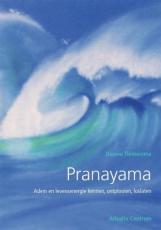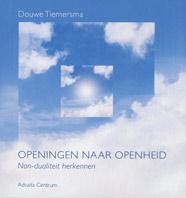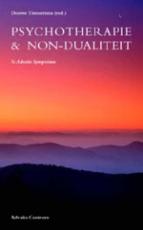Advaita Post 09 -09 - A feeling is skin and wind...

Advaita Post 9 -09, May 17
--- A feeling is skin and wind ---

movement
of sunspots and leafy shadow;
the coo of a dove.
Silence.
Where is time?
Timelessly play light and dark,
strikes wind across my open skin.
Where am I?
One feeling is skin and wind.
As skin-wind I blow through the trees,
green skin-wind of the shuddering leaves.
The incredibly soft sound becomes so strong
that I and everything within it disappear.
I savour the nectar of the flowers;
Sated, I realize that there is nothing more than that: one taste.
Seeing is mingling with glare and shadow,
being the rapidly changing light and dark and
their source without a second, without time or place.
This introductory text appeared in: OHM-Vani (Organization for Hindu Media) No 14-2 (April / June 2008), p. 32-34
Life in our society demands a lot. The pressure is not only in work and study, but also in other areas of life. There are all kinds of things deemed necessary by others and by yourself. There are the continuous psychological processes of thinking and feeling, containing difficult questions, conflicts and imbalances seeking a solution. Meditation lets all of these tensions disappear, and the good news is: you can learn it.
In the internal and external forcefields there are strong tensions and instabilities, experienced not only by the elderly, but also by many youths. Their consequences include uncertainty, brooding, concentration problems, insomnia, depression, and anxiety, but also insensitivity and indifference.
Many people begin to meditate in order to rise above their tension and unrest. The Indian tradition offers many methods of meditation. Naturally, meditation is not only therapeutic, as it has traditionally been focused on the release of all tensions and restrictions, it is also directed towards the realization of unity with the source of All (moksha). Yet, meditation also helps people who are active in society. In all types of meditation there are two very important elements: relaxation and consciousness.
Focussing
Tension exists as an element within the focus towards all kinds of things and problems. Relaxation is possible as you bring the focus back into yourself. Let the attention that goes out from you return to the source that you are, and: the tension is gone. This is the beginning of meditation. In yourself as the source of attention there is only silence and peace. As you become aware of it by returning to this place, you yourself are calm and peace. This reveals itself as unfolding in all directions, universal: peace is everywhere. As you thus remain at home, external actions have no effect upon you anymore. You'll notice that exactly the opposite happens: the relaxation and peace affect others too!
Meditatieve relaxation
Once you've experienced what meditative relaxation is, you can always return there. You need only to imagine a situation in which you were totally relaxed. Do you have such a memory? Then go once again to that situation within and there is once again rest. If you know that meditative relaxation very clearly, then you can focus directly on it, so that it grows steadily stronger. You need only to think of the relaxation and you slide into it, spontaneously. That is why I call it Spontaneous Relaxation:
"Return awareness back to your body and your bodily situation here and now. Notice that a relaxation occurs spontaneously and your mind becomes still. Let this continue with an ongoing attention. While remaining clear, let the relaxation go deeper and the silence grow. Surrender to the stillness and the relaxation. This is how meditation develops. Everything opens. Do this as often as possible." (from Learning to Meditate, Ch.1, 1.5)
It is a worthwhile effort to learn to experience that you can always stay relaxed in the source of yourself in all circumstances.
Constant vigilance
In order to remain aware of yourself relaxation is necessary, if only to avoid going too easily with everything that demands your attention. As you become aware of your own relaxed depth, then the relaxation can more easily return or continue and finally always remain. Additionally, it's also good to stay more aware of yourself in everyday life, in all situations. Then you'll see what is happening in a larger space. Then you can more easily release all the different sorts of things creating tensions and go your own way. When you stick to this kind of awareness in this way, it is called insight meditation.
A corresponding western form is currently known as mindfulness. It is a constant awareness practiced throughout the day. As a special meditation in a seated position it runs as follows:
"Go with your attention towards the breathing process in your lower belly, but remain with an open attention on the greater space in which this process occurs. Notice directly when something distorts the openness and claims your attention... let it go, relax yourself and return again to the opening position."
(from: Learning to Meditate, Ch.2, 2.3)
Unity
These meditations with the emphasis respectively on relaxation and insight may deepen. The meditation on an image of Krishna, Kâlî, Shiva, Ganesha or another divine figure lets the essence of that image become a reality in your own sphere. By meditating in this way you literally come to live within the corresponding divine atmosphere and you merge more and more together with the god. It is a mystical movement towards unity with God. The Yogasûtras of Patañjali guide the meditation towards a one-being (samâdhi), in which the mental processes are completely stilled. Then, there is no observation and thinking anymore. In the Advaita Vedânta the emphasis is on the insight of the one-being as the basis of yourself and that of the world. It is about being-awake, that is a realisation of the highest one-being, while the world and the person can continue to remain present without difficulties. The meditation is maintaining a focused awareness on the basic foundation and letting yourself fall into it; see the description of Spontaneous Meditation earlier in this article.
Becoming familiar
So everyone has the possibility to learn to relax with awareness, to gain more insight about your situation of tension-relaxation and your original nature and how to remain within it. Therefore it's usually necessary to meditate regularly, but also returning to an aware relaxation a few times a day helps to remedy many problems. Especially for young people, becoming familiar with aware relaxation is worthwhile, because they have a whole life to lead ahead of them. In a project of the Advaita Centre many young people learn this through small exercises (pitstops).
The return to the depths of yourself means relaxation and peace. It also means independence from the circumstances. You are no longer carried away by the various forces that are active internally and externally of you. And so you no longer go along with the ideas proposed by others that you are nothing more than the workings of your brain, see for example, "Mysticus thinks like a rabbit '(Volkskrant on January 7, 2008). You're more than what neurobiological science says because you're more than your brain. You are yourself as Being and you are not the object of science or of anyone else. Meditation can teach you that, too.
Er is geen tweeheid
als je ontspannen bent
in zelf-bewustzijn
is dat duidelijk.
Boeken
Douwe schreef en redigeerde gedurende zijn leven boeken. Via onze uitgeverij zijn deze nog verkrijgbaar.



